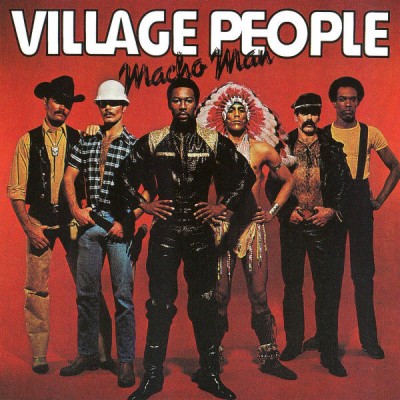The Village People is the name of an iconic disco group that was popular in the late 1970s dance club scene. The Village People brought Gay male sensibilities and humor to the mainstream pop music scene by appealing to both Gay and Straight audiences with their performance of masculinity and non-effeminate camp.
As singers, the Village People were basically members of a novelty pop band. As performers representing the Gay male community, however, they were among the first to embody a new masculine ideal for Gay men, and sang coded lyrics that were specifically taken from Gay male folk speech and geography.
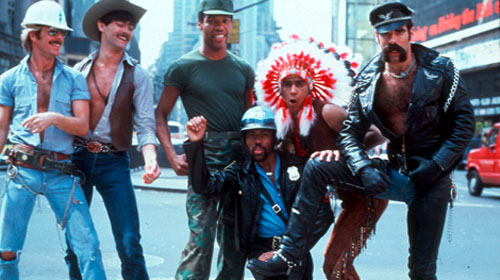
Village People in their movie, Can’t Stop the Music (tumblr.com/tagged/village%20people?before=97, January 2013)
Iconography
Formed in New York in 1977, the six members of the Village People dressed as homoerotic icons, and offered audiences a tableau of masculinity to counteract the stereotypical nelly queen (effeminate Gay man) aesthetic. The Village People reflected the rise of the ultra-masculine, physically fit gay clone of the 1970s and 1980s.
Most fans knew the original members of the group by their roles rather than their names: the Cowboy (Randy Jones), the Indian (Felipe Rose), the Construction Worker (David Hodo), the Cop (Victor Willis), the Soldier (Alex Briley), and the Biker/Leather Daddy (Glenn Hughes). Though all characters impersonated the objects of Gay male fantasy, they purposefully avoided discussion of sexual orientation. Only the Cowboy and Indian were openly Gay.
Music and Lyrics
The music of the Village People is upbeat, with syncopated rhythms, a strong 4X4 beat, ebullient horns, and call-and-response vocals. The lyrics are loaded with Gay folk references. Much of the content was based not on what Straight people thought the “gay lifestyle” was, but on actual moments of Gay history and folklife. For example, the lyrics of “YMCA” can be read as a celebration of real male camaraderie and sexual possibilities to be found in the communal showers at the Sloane House YMCA in New York City, a favorite hangout for homosexual GIs during World War II. Ironically, “YMCA” found its way onto to the play list of sports stadiums in America, and is held dear by millions of presumably Straight fans and their families despite (or perhaps because of) the double entendre of lyrics such as “They’ve got everything for young men to enjoy / You can hang out with all the boys,” and the constant repetition of the phrase, “Young men.”
Other hits like “Fire Island” (1977), “Macho Man” (1978) and “In the Navy” (1979) refer to locales and characters rich with meaning. The lyrics of “Fire Island” name gay men’s dance clubs and bars in Cherry Grove and Fire Island Pines on the south end of Fire Island (a barrier island off Long Island, New York), such as the Sandpiper, Monster, Ice Palace, and Blue Whale. “Macho Man” refers to Leather sado-masochistic culture with the lyrics, “Call him Mr. Eagle [from the Leather bar, the Eagle], dig his chains.” The romantic verses of “Go West” (1979) describe a couple’s desire to “begin life new” together where “life is peaceful.” The song hints that such a tender vision of Gay love can only be realized in a far-off utopia, and the lovers must go there to fulfill their devotion. The song, “Sodom and Gomorrah” lampoons the Biblical story in Genesis that is so often used to condemn the entire LGBTQ community. The chorus, “Give me 50 [40, 30, 20, 10, 2] good men” refers both to God’s promise to Abraham that He would not destroy Sodom if honest men could be found, but also implies the singers want good men for erotic pleasure.
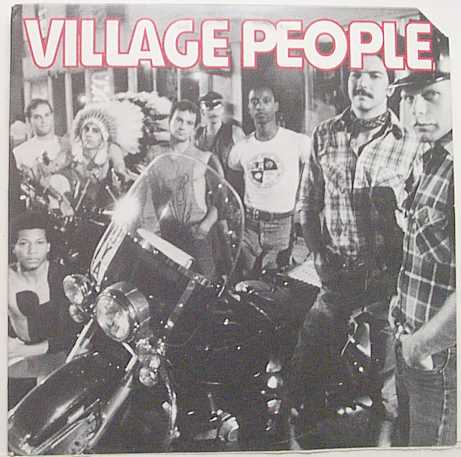
First album: still raw, still establishing their act (cdandlp.com/item/2/0-1701-0-11-0/1085176704/village-people-village-people.html, January 2013)
To Gay audiences, the meaning of coded Gay folk speech was obvious when these songs were released. Straight listeners were not threatened by references they did not understand.
In the Navy
In 1979, the Village People released “In the Navy,” a song that outwardly praised military service at sea. Intending to use the song for recruiting, the US Navy had gone so far as to allow the Village People to shoot the video for the song on board one of their ships. Complaints that taxpayers’ money was being used to finance a pop music video by a controversial group, and the double entendre in lyrics like “They want you / They want you / They want you as a new recruit,” forced the Navy to drop its plans to use the song. On popular radio, however, “In the Navy” was an international hit.
Interpretation
Intentional ambiguity in the Village People’s lyrics and personae allowed Straight and Gay fans to interpret the band in different ways. Straight followers saw a goofy, fun-loving crew of characters. Gay admirers encountered a group dressed as their favorite images of butch (masculine) men, with a distinctly Gay awareness in their coordinated dance moves and gestures. The Village People legitimized the masculine aesthetic in Gay male folklife, and challenged Straight America to see Gay men as strong and respectable.
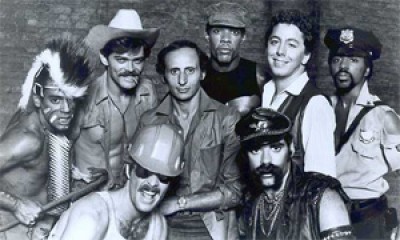
Henri Belolo (next to the Cowboy) and Jacques Morali (just above the Leatherman) were the creators of and the brains behind the Village People (disco-disco.com/tributes/henri.shtml, January 2013)
Though campy, the Village People were never effeminate. This distinction may not have registered with Straights, but to Gay fans, their masculine bearing introduced a counterpart to the drag queens and the stereotypical limp-wristed fairies in popular culture.
Disco Demolition
Any hopes of Gays and Straights forming a united club culture ended as homophobic backlash (due in part to a flood of poorly-made disco songs) led to the “death” of disco, not too long after the Village People made their debut. “Disco Sucks” and “Kill Disco” were common slogans for rock music purists like Chicago radio DJ Steve Dahl, who called for a “disco destruction army” to verbally assault DJs that played disco music. In one publicity stunt, Dahl gave away 100 tickets to a Village People concert so that disco-haters could harass the performers. “Disco music is a disease,” Dahl warned his followers.
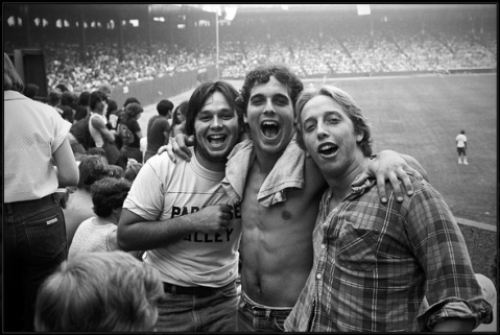
Disco Demolition attendees, just before fans took to the field and wrecked it (fangraphs.com/not/index.php/apropos-of-nothing-disco-demolition-night-1979, January 2013)
On July 12, 1979, Dahl pulled his biggest anti-disco stunt. He supervised a “Disco Demolition” rally at Chicago’s Comiskey Park during a baseball double-header between the Detroit Tigers and the Chicago White Sox. After the first game, Dahl in paramilitary gear went on the field and burned several thousand disco albums that fans had brought in exchange for reduced admission. The album-burning excited the spectators into a frenzy— thousands of them poured onto the field, ripped up the turf, set more fires, and attempted to storm the locker rooms of the baseball players while chanting “Disco Sucks!” The White Socks ended up forfeiting the game.
Once the Disco Sucks movement spread throughout America, the Village People quickly fell out of favor. Their ambiguity made them too Gay and too disco for Straight people, and they never really caught on with the still-growing Gay men’s dance scene of the early 1980s. Today, the group has cult celebrity status, and continues to put on shows for predominantly Straight crowds.
YMCA Dance
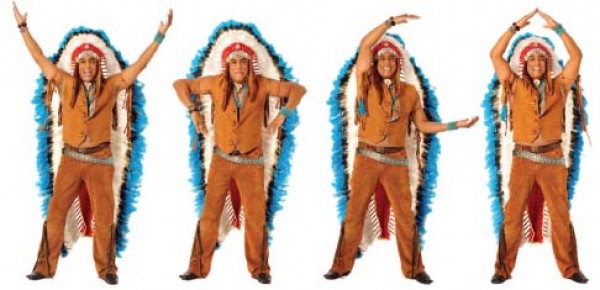
From the official website: Felipe teaches the YMCA dance (officialvillagepeople.com/photos/felipe-teaches-the-ymca-dance, January 2013)
An enduring performance legacy of the Village People is the YMCA dance, taken from choreography used by the group when the song “YMCA” was popular. The dance is performed individually by raising arms in the air so that they form the top of the letter Y, then the dancer shifts the arms to an M with forearms facing each other, hands pointed down at a 45-degree angle with the outside tips of the middle fingers touching. The next move forms a C by curving both arms to the left side, left arm low, right arm high, and finally an A by raising both arms over the head with an inward angle so that inside of the extended middle fingertips are touching. There is no definitive choreographed set of leg movements. The YMCA dance is performed whenever the song “YMCA” is played, be it venues such as sports arenas, or celebrations such as weddings and bar mitzvahs.
– Kat Long and Mickey Weems
QEGF Authors and Articles
QEGF Introduction
Comments? Post them on our Encyclopedia facebook page.
Further reading:
Brewster, Bill and Frank Broughton. Last Night a DJ Saved My Life: The History of the Disc Jockey. New York: Grove, 2000.
Gage, Simon and Lisa Richards, Howard Wilmot, and Boy George. Queer. New York: Thunder Mouth, 2002.
Lawrence, Tim. Love Saves the Day: A History of American Dance Music Culture, 1970-1979. Durham, NC: Duke University Press, 2003.
Peraino, Judith Ann. Listening to the Sirens: Musical Technologies of Queer Identity from Homer to Hedwig. Berkeley: University of California Press, 2006

